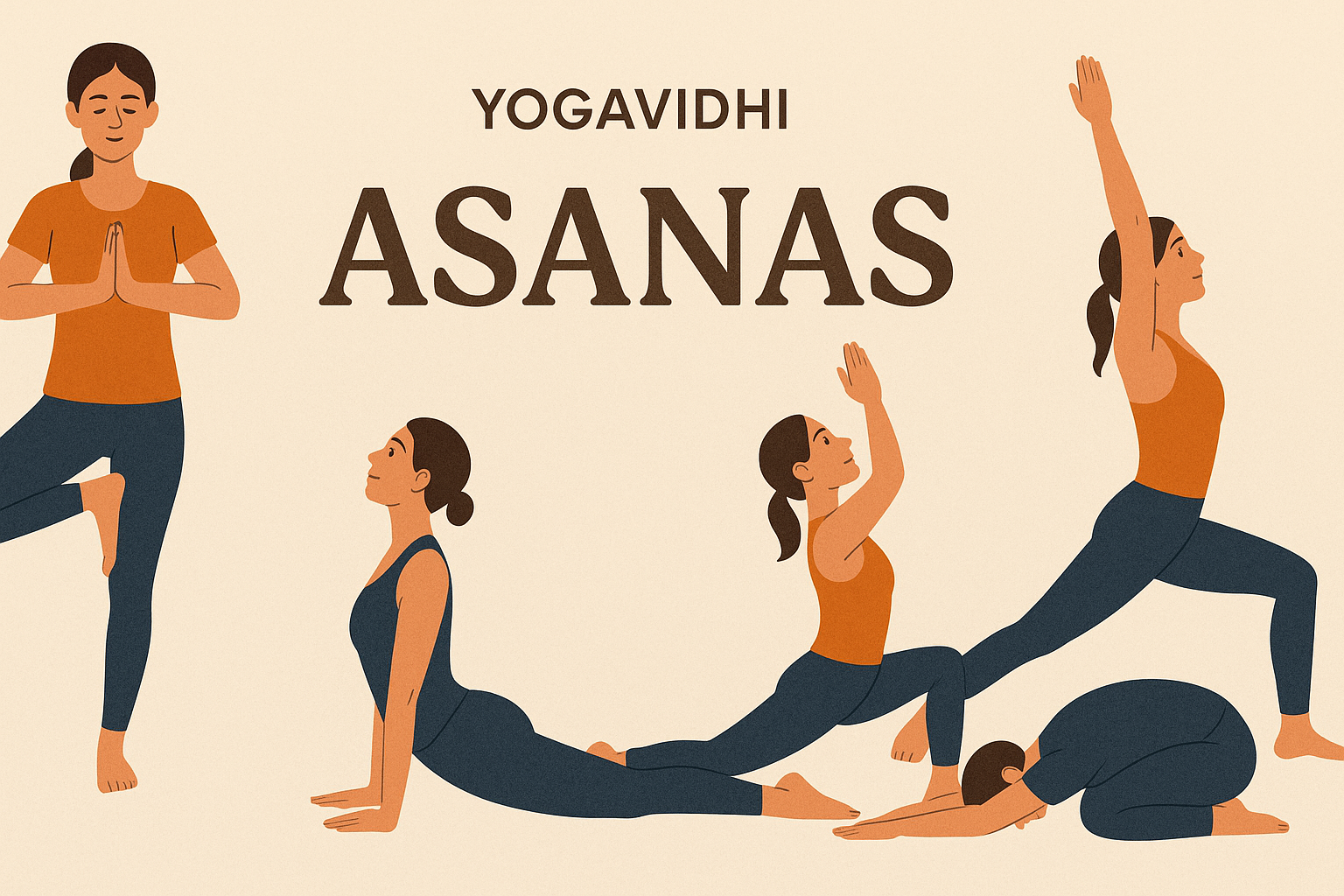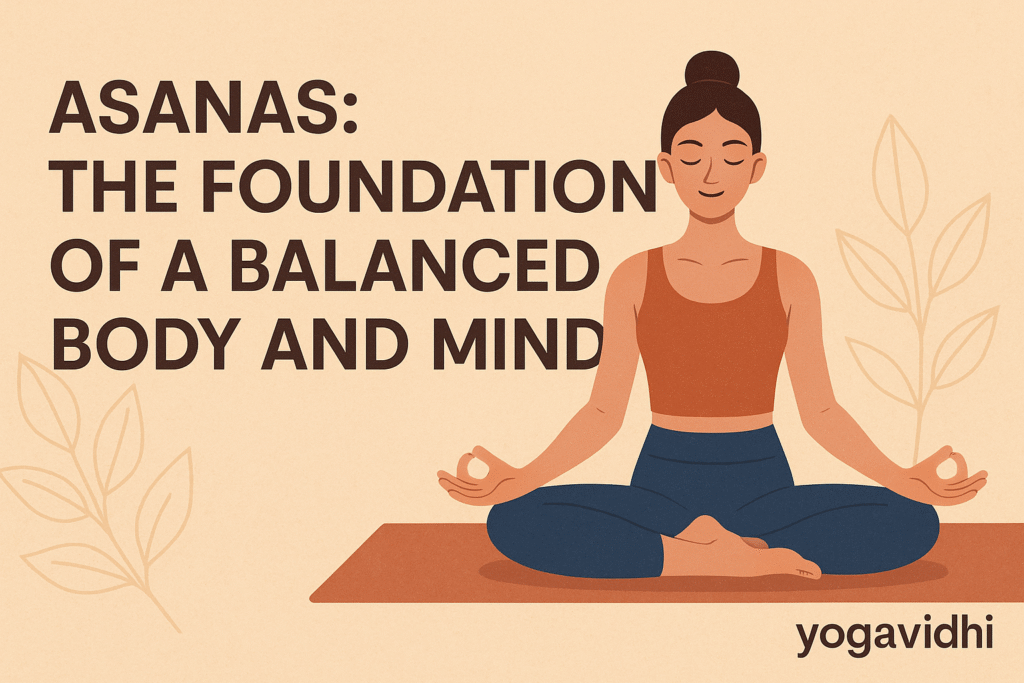In the modern-day rush to find balance, peace, and wellness, the ancient science of yoga has emerged as a trusted companion. At the heart of yoga lie asanas—the physical postures that harmonize the body, mind, and soul. While many associate yoga with flexibility, the deeper truth is that asanas are tools for transformation—both on and off the mat.
Whether you’re a beginner stepping into your first yoga class or an experienced practitioner refining your technique, understanding the power and purpose of asanas can elevate your practice—and your life.
Asanas are physical postures used in yoga practice. The word “asana” comes from Sanskrit and originally meant “seat,” primarily indicating positions for meditation. In modern yoga, however, it includes a broad range of poses such as standing, seated, inverted, twisting, and balancing postures.
Table of Contents
What Are Asanas?
The word asana originates from the Sanskrit root “ās,” which means “to sit” or “to be present.” In yogic philosophy, asanas refer to the physical postures used in yoga practice not just for exercise, but for stillness, awareness, and inner alignment.
Originally described in Patanjali’s Yoga Sutras, asanas were intended to prepare the body for prolonged meditation. Today, yoga asanas have evolved into a rich tapestry of postures that support health, stability, strength, and spiritual growth.
Why Asanas Matter in Yoga
Asanas are not simply stretches. They are intentional movements and holds designed to:
- Activate the energy channels (nadis) within the body
- Balance the chakras (energy centers)
- Improve physical and mental well-being
- Cultivate awareness, focus, and discipline
In essence, practicing asanas trains the body to become a steady, supportive vessel for higher consciousness.
Top Benefits of Practicing Asanas
Here are some of the top science-backed and traditional benefits:
1. Physical Health
- Improves flexibility and joint mobility
- Builds strength and muscle tone
- Enhances posture and alignment
- Aids digestion and circulation
- Supports immune and respiratory health
2. Mental Clarity
- Reduces stress, anxiety, and mental fog
- Enhances mood and emotional balance
- Improves concentration and memory
3. Spiritual Connection
- Deepens the connection with the breath
- Promotes mindfulness and self-awareness
- Prepares the body for meditation
When practiced regularly, asanas become a moving meditation that calms the mind and energizes the spirit.
Types of Asanas (Based on Posture and Purpose)
There are hundreds of asanas in yoga, but they can be grouped into categories for easier understanding:
1. Standing Asanas
Great for grounding, building strength, and improving posture.
Examples: Tadasana (Mountain Pose), Trikonasana (Triangle Pose)
2. Sitting Asanas
Ideal for meditation, breathwork, and spinal flexibility.
Examples: Sukhasana (Easy Pose), Padmasana (Lotus Pose)
3. Supine (Lying on Back) Asanas
Promote relaxation, core strength, and spinal release.
Examples: Setu Bandhasana (Bridge Pose), Supta Baddha Konasana (Reclined Bound Angle)
4. Prone (Lying on Stomach) Asanas
Enhance digestion, stimulate abdominal organs, and strengthen the back.
Examples: Bhujangasana (Cobra Pose), Dhanurasana (Bow Pose)
5. Inverted Asanas
Increase circulation to the brain, promote detox, and improve focus.
Examples: Sarvangasana (Shoulder Stand), Halasana (Plow Pose)
6. Balancing Asanas
Build coordination, core strength, and concentration.
Examples: Vrikshasana (Tree Pose), Bakasana (Crow Pose)
15 Most Popular Asanas and Their Benefits
Let’s dive into some of the most practiced and recommended yoga asanas around the world:
| Asana | English Name | Benefits |
| Tadasana | Mountain Pose | Improves posture, stability |
| Vrikshasana | Tree Pose | Enhances balance and focus |
| Adho Mukha Svanasana | Downward Facing Dog | Strengthens arms and back |
| Bhujangasana | Cobra Pose | Opens the chest and spine |
| Trikonasana | Triangle Pose | Increases flexibility |
| Paschimottanasana | Seated Forward Bend | Calms the nervous system |
| Utkatasana | Chair Pose | Tones legs and glutes |
| Setu Bandhasana | Bridge Pose | Opens heart and shoulders |
| Navasana | Boat Pose | Builds core strength |
| Shavasana | Corpse Pose | Promotes total relaxation |
| Padmasana | Lotus Pose | Ideal for meditation |
| Dhanurasana | Bow Pose | Strengthens back and opens hips |
| Balasana | Child’s Pose | Relieves stress and tension |
| Ustrasana | Camel Pose | Stimulates thyroid and spine |
| Halasana | Plow Pose | Improves circulation and sleep |
These yoga asanas for beginners and experienced practitioners form the core of many yoga sequences.
How to Practice Asanas Safely
As with any physical activity, practicing asanas with awareness is key. Here are a few essential tips:
- Always warm up with gentle stretches and breathwork
- Move slowly and never force your body into a pose
- Use props like blocks, bolsters, and straps for support
- Listen to your breath if it’s strained, ease out of the pose
- Avoid practicing intense asanas during illness, menstruation, or pregnancy without expert guidance
Read More: Postnatal Yoga: Rebuild, Restore, and Reconnect After Birth
Read More: Yoga Courses: Find the Right Path to Your Wellness Journey
How to Structure a Balanced Asana Sequence
A well-rounded asana practice brings harmony to body and mind. Here’s how you can structure your yoga flow:
- Begin with grounding poses (like Sukhasana or Tadasana)
- Add warming movements (Sun Salutations)
- Include a mix of standing, seated, twisting, and inverted asanas
- Balance backbends with forward bends
- Finish with restorative postures and Shavasana
This approach ensures the nervous system is regulated, and each body part receives attention.
Asanas for Specific Needs
Whether you’re practicing yoga at home or attending a class, here’s how you can choose asanas based on your goal:
For Flexibility
Try: Trikonasana, Paschimottanasana, and Uttanasana
For Strength
Try: Plank Pose, Utkatasana, and Navasana
For Stress Relief
Try: Balasana, Viparita Karani, and Shavasana
For Back Pain
Try: Bhujangasana, Setu Bandhasana, and Cat-Cow
For Seniors or Limited Mobility
Try: Chair Yoga Asanas, Supine Poses, and Gentle Twists
The Role of Breath in Asana Practice
One of the biggest mistakes in modern yoga is treating asanas like a workout. The breath is the soul of asanas. Each posture should be guided by slow, conscious breathing – this creates a meditative state, activates the parasympathetic nervous system, and deepens the effect of the pose.
Inhale to lift, exhale to release. This simple rhythm can transform your entire experience.
Common Mistakes to Avoid While Practicing Asanas
Even seasoned yogis sometimes fall into these traps:
- Forcing the body into “Instagram-perfect” poses
- Ignoring pain or discomfort signals
- Skipping warm-up or cool-down
- Practicing without proper alignment
- Forgetting to end with relaxation
The goal of yoga asanas is not perfection, but presence. Honor your body as it is today.
Advanced Asanas and When to Try Them
Once you’ve built consistency with foundational postures, you may feel ready to explore more advanced asanas like:
- Sirsasana (Headstand)
- Mayurasana (Peacock Pose)
- Eka Pada Koundinyasana (Arm Balance)
These require strength, balance, and mental focus. Always learn under the guidance of an experienced teacher to prevent injury and build safely.
Bringing Asanas into Daily Life
You don’t need an hour-long session every day to feel the benefits of yoga. Try:
- 10-minute morning flow to awaken the body
- 5-minute chair yoga break at work
- Evening stretches to release tension
- Weekend family yoga for bonding
Make asanas a part of your lifestyle, not just your fitness routine.

Conclusion: Embrace the Power of Asanas
Asanas are more than just physical postures. They are sacred shapes that support strength, serenity, and spiritual growth. Whether you’re practicing yoga for physical health, emotional balance, or spiritual connection, asanas are your bridge to a more conscious, vibrant life.
Begin with awareness. Practice with compassion. Grow with patience.
Frequently Asked Questions (FAQs):
Q. What are asanas in yoga?
Ans: Asanas are the physical postures practiced in yoga to build strength, flexibility, and balance while calming the mind. Originally, asanas were designed to prepare the body for meditation, but today they are recognized for their wide-ranging health benefits.
Q. How many types of asanas are there?
Ans: There are hundreds of asanas, but they are commonly classified into six categories: standing, sitting, prone (on the stomach), supine (on the back), balancing, and inverted asanas. Each type targets different areas of the body and serves a specific purpose.
Q. What are the benefits of practicing asanas daily?
Ans: Daily practice of asanas improves posture, flexibility, and strength while reducing stress and anxiety. It boosts circulation, improves digestion, supports joint health, and promotes a calm and focused mind. Asanas also help regulate energy flow and balance the body’s internal systems.
Q. Can beginners practice yoga asanas safely at home?
Ans: Yes, beginners can safely start practicing yoga asanas at home by beginning with simple poses like Tadasana, Balasana, and Cat-Cow. It’s important to warm up, follow proper alignment, use props when needed, and listen to your body. Online classes or guided videos can be very helpful.
Q. What is the best time to do asanas?
Ans: The best time to practice asanas is in the early morning on an empty stomach, as it energizes the body for the day. However, you can also practice in the evening for relaxation. Consistency is more important than the time of day—choose a time that fits your schedule and allows you to be regular.
Q. What do you mean by asanas?
Ans: In yoga, the term “asana” (आसन) signifies a physical posture, pose, or position. Derived from Sanskrit, it originally meant “seat,” particularly for meditation. Over time, its meaning has broadened to include a wide range of bodily positions practiced in yoga. Asanas form a fundamental part of Hatha yoga and play a vital role in enhancing both physical and mental health.
Q. What are the aims of asana?
Ans: Realistic short-term goals may include improved strength and flexibility, a clearer and lighter mind, a greater sense of calm and wellbeing, and better impulse control. These goals vary for each person and are constantly evolving.
Q. How many asanas per day?
Ans: There isn’t a universal rule for how many asanas to practice each day. A practical starting point is 15 to 30 minutes, focusing on a few poses that feel comfortable and supportive for your body. Beginners can start with a simple 15-minute routine featuring a handful of asanas. As your flexibility and confidence grow, you can slowly expand both the number of poses and the duration of your practice.
Declaration Note:
We use third-party videos and images on https://yogavidhi.com/ for educational and illustrative purposes. All rights belong to their respective owners. No copyright infringement is intended.



